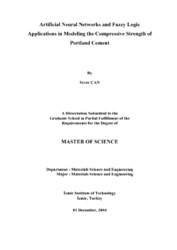Please use this identifier to cite or link to this item:
https://hdl.handle.net/11147/3328Full metadata record
| DC Field | Value | Language |
|---|---|---|
| dc.contributor.advisor | Akkurt, Sedat | en |
| dc.contributor.author | Can, Sever | - |
| dc.date.accessioned | 2014-07-22T13:51:20Z | |
| dc.date.available | 2014-07-22T13:51:20Z | |
| dc.date.issued | 2004 | en |
| dc.identifier.uri | http://hdl.handle.net/11147/3328 | |
| dc.description | Thesis (Master)--Izmir Institute of Technology, Materials Science and Engineering, Izmir, 2004 | en |
| dc.description | Includes bibliographical references (leaves: 43) | en |
| dc.description | Text in English; Abstract: Turkish and English | en |
| dc.description | ix, 44 leaves | en |
| dc.description.abstract | Portland cement production is a complex process that involves the effect of several processing parameters on the quality control of 28-day cement compressive strength (CCS). There are some chemical parameters like the C3S, C2S, C3A, C4AF, and SO3 contents in addition to the physical parameters like Blaine (surface area) and particle size distribution. These factors are all effective in producing a single quantity of 28-day CCS. The long duration of 28 day CCS test provided the motivation for research on predictive models. The purpose for these studies was to be able to predict the strength instead of waiting for 28 days for the test to be complete. In this thesis, artificial intelligence (AI) methods like artificial neural networks (ANNs) and fuzzy logic were used in the modeling of the 28-day CCS. The two models were compared for their quality of fit and for the ease of application.Quality control data from a local cement plant were used in the modeling studies. The data were separated randomly into two parts: the first one contained 100 data points to be used in training and the second part had 50 data points to be used in testing stages of the models. In this study, four different AI models were created and tested (3 ANN, 1 fuzzy logic). One of the ANN models (Model A) had 20 input parameters in 20x20x1 architecture with testing average absolute percentage error (AAPE) of 2.24%. The other ANN model (Model B) had four input parameters (SO3, C3S, Blaine and total alkali amount) in 4x4x1 architecture with AAPE of 2.41%. Both of the Model A and the Model B were created in the MatLAB® environment by writinga custom computer code. The last ANN model (Model C) actually refers to 72 differentANN models created in the MatLAB® neural networks toolbox. In order to obtain a model with the lowest error, different learning algorithms, training functions and architectures in combinations were tested. The lowest AAPE among these models appeared to be 2.31%. The fuzzy logic model (Model D) which had four input parameters (SO3, C3S, Blaine and total alkali amount) was created in the MatLAB fuzzy logic toolbox. In order to write the fuzzy rules, the sensitivity analysis of the Model B was utilized. The AAPE of the Model D was 2.69%. The model was compared with the ANN models for its error levels and ease of application. The results indicated that through the application of fuzzy logic algorithm, a more user friendly andmore explicit model than the ANNs could be produced within successfully low error margins. | en |
| dc.language.iso | en | en_US |
| dc.publisher | Izmir Institute of Technology | en |
| dc.publisher | Izmir Institute of Technology | en_US |
| dc.rights | info:eu-repo/semantics/openAccess | en_US |
| dc.subject.lcc | TP883 .C21 2004 | en |
| dc.subject.lcsh | Portland cement | en |
| dc.subject.lcsh | Fuzzy logic | en |
| dc.subject.lcsh | Neural networks (Computer science) | en |
| dc.title | Artificial neural networks and fuzzy logic applications in modeling the compressive strength of portland cement | en_US |
| dc.type | Master Thesis | en_US |
| dc.institutionauthor | Can, Sever | - |
| dc.department | Thesis (Master)--İzmir Institute of Technology, Materials Science and Engineering | en_US |
| dc.relation.publicationcategory | Tez | en_US |
| item.languageiso639-1 | en | - |
| item.fulltext | With Fulltext | - |
| item.openairecristype | http://purl.org/coar/resource_type/c_18cf | - |
| item.openairetype | Master Thesis | - |
| item.grantfulltext | open | - |
| item.cerifentitytype | Publications | - |
| Appears in Collections: | Master Degree / Yüksek Lisans Tezleri Sürdürülebilir Yeşil Kampüs Koleksiyonu / Sustainable Green Campus Collection | |
Files in This Item:
| File | Description | Size | Format | |
|---|---|---|---|---|
| T000476.pdf | MasterThesis | 1.86 MB | Adobe PDF |  View/Open |
CORE Recommender
Page view(s)
124
checked on Jul 22, 2024
Download(s)
64
checked on Jul 22, 2024
Google ScholarTM
Check
Items in GCRIS Repository are protected by copyright, with all rights reserved, unless otherwise indicated.